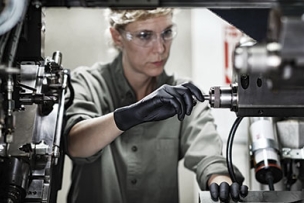Chemicals: Workers in food manufacturing environments often come into contact with oils, acids, solvents and cleaners that can be harsh on skin and also can damage some glove materials. Pick a chemical-resistant glove—coated with nitrile or latex, for example—and consider one with a safety cuff to protect the wrist and forearm from splashes.
Layer Multiple Gloves for Maximum Protection
Given the diverse range of tasks being performed across food manufacturing facilities, there may be no single glove that protects against every hazard. To offer sufficient protection, the solution may be to layer multiple gloves.
“The application will always dictate what is needed,” Beddigs says. “Food processing roles, such as slaughterhouse, chicken deboning and meat processing, will certainly require not only a single-use disposable glove but a cut-resistant glove as well.”
Read more: Food Safety PPE: A Guide to PPE Selection in Food Manufacturing
Food manufacturing workers should start by wearing a glove that protects against contaminants in the food and prevents cross-contamination of germs or bacteria. Then they should layer additional gloves as needed for the hazards of their specific jobs—some gloves may offer combined protection. Advances in technology have led to finer materials, so you won’t sacrifice dexterity even when layering gloves.
Look for FDA-Approved Materials
The Food and Drug Administration (FDA) maintains standards for safe practices in the food industry. Regulations call for food handlers to use gloves and other PPE made from food-safe materials that don’t leach into food.
Gloves bearing an FDA approval seal indicate they are safe for direct use with food. Many approved food handling gloves are made of latex or nitrile. Products that are not certified for food handling—such as medical-grade gloves or those intended for other manufacturing industries—might seem OK on the surface but could contain permeable materials and therefore are noncompliant.
Select Comfortable Gloves
Food manufacturing workers spend hours wearing gloves during their shifts. If they are wearing a pair that is too tight or too loose or that is made of stiff fabric that limits movement, workers are less likely to keep them on. This not only puts workers at risk of injury or illness, but it also places employers at risk of FDA and Occupational Safety and Health Administration violations.
“People are always looking for something that offers not only safety, but comfort and dexterity,” Beddigs says. “They want to wear something that doesn’t hinder their job performance.”
By selecting gloves with a comfortable fit and the safety features required for the work at hand, manufacturers can protect their employees, consumers and their own businesses.








Talk to Us!
Leave a reply
Your email address will not be published. Required fields are marked *